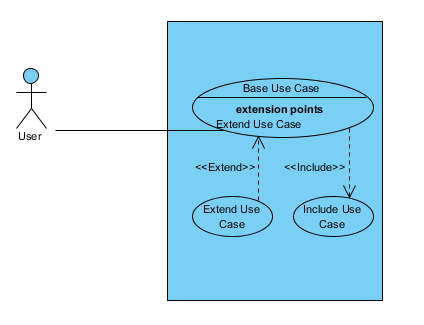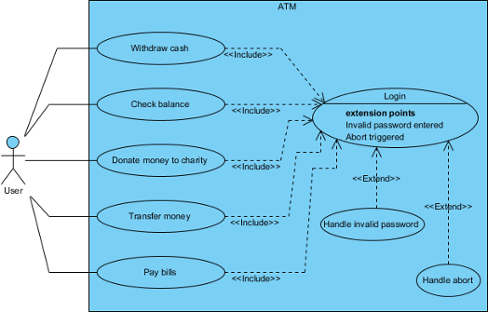Structuring Use Cases with Base, Include, and Extend: A Guide for Effective Software Development
What is Use Case Modeling
Use cases are an important tool in the field of software development, as they help to specify how a user will interact with a particular system. They provide a clear and concise way to document the functionality of a system, and can be used to ensure that developers are building software that meets the needs of its intended users. When creating use cases, it is important to structure them in a way that makes them easy to understand and implement. One way to do this is to use the concepts of base, include, and extend use cases.
Base Use Cases:
Base use cases represent the core functionality of a system. They are the basic building blocks that define what a system can do. Base use cases are typically used to represent the primary functions of a system, and are often the most important use cases in a system. When creating base use cases, it is important to keep them simple and easy to understand. They should be written in a way that is easy to follow and should be as concise as possible.

Include Use Cases:
Include use cases are used to represent functionality that is shared across multiple use cases. They allow you to avoid duplicating the same functionality across multiple use cases, and instead refer to a single use case that contains the shared functionality. This can help to reduce the complexity of your use cases, and make them easier to understand and maintain. When creating include use cases, it is important to make sure that the included functionality is clearly defined and easy to understand. You should also make sure that the included use case is written in a way that makes it easy to reuse.
Extend Use Cases:
Extend use cases are used to represent functionality that is optional or conditional. They allow you to define functionality that is only used under certain conditions, or when a user chooses to use a particular feature. When creating extend use cases, it is important to make sure that the extended functionality is clearly defined and easy to understand. You should also make sure that the extended use case is written in a way that makes it easy to understand how it relates to the base use case.
Extension Point in Use Case Diagram
An extension point in a use case diagram represents a point in a use case where behavior can be extended or modified by another use case. It is a specific point within a use case where an extension use case can be connected to provide additional or optional functionality.
An extension point is a labeled arrow that connects a use case to an extension point within another use case, indicating the point at which the extension use case can be included. It is represented as a small circle with a name or a number that identifies the point where the extension occurs.
Extension points are identified during the analysis and design phase of the software development life cycle. They are typically defined in the base use case with a description of the extension scenario and the conditions under which the extension point can be invoked.
The extension point allows for the inclusion of new functionality or behaviors that were not included in the initial use case, without modifying the base use case itself. This modular approach to use case design makes it easier to modify and extend the system’s functionality as the requirements change over time.
Structuring Use Cases:
When structuring use cases, it is important to keep the concepts of base, include, and extend use cases in mind. You should start by defining your base use cases, which represent the core functionality of your system. From there, you can define include use cases that represent shared functionality, and extend use cases that represent optional or conditional functionality. It is important to make sure that your use cases are well-defined and easy to understand. You should also make sure that your use cases are organized in a way that makes it easy to see how they relate to each other.

ATM Include Use cases – Login Use Case
The <<include>> use case relationship is used to represent the inclusion of one use case within another. In the context of an ATM system, the login use case is included in other use cases such as Withdraw Cash, Deposit Funds, and Check Balance, as these use cases require the user to first authenticate themselves through the login process.
In other words, the Withdraw Cash use case can be considered as a base use case that requires the user to be logged in before it can be executed. In this scenario, the Login use case is an included use case because it is necessary to include it within the Withdraw Cash use case in order to complete the transaction. This ensures that only authorized users are able to withdraw cash from their accounts.
In general, the Login use case is an included use case in most other use cases of an ATM system because authentication is a prerequisite for most transactions.
ATM Extend Use Cases – InValid Password or Cancel Use Case
The Login use case typically has an extend use case for Invalid Password, which handles the scenario where the user enters an incorrect password. This use case can provide feedback to the user about the error and prompt them to re-enter their password or reset it if necessary.
The Login use case can also have an extend use case for Cancel, which handles the scenario where the user decides to cancel the login process before it is completed. This use case can terminate the login process and return the user to the main menu or the ATM’s idle state.
Both the Invalid Password and Cancel extend use cases can help improve the usability of the ATM system and provide a better user experience for customers.
Conclusion:
Structuring use cases with base, include, and extend use cases is an effective way to create clear and concise use cases that are easy to understand and implement. By using this approach, you can create use cases that accurately represent the functionality of your system, while avoiding unnecessary complexity and duplication of effort. Whether you are a software developer, business analyst, or project manager, using this approach can help you create high-quality software that meets the needs of its intended users.

